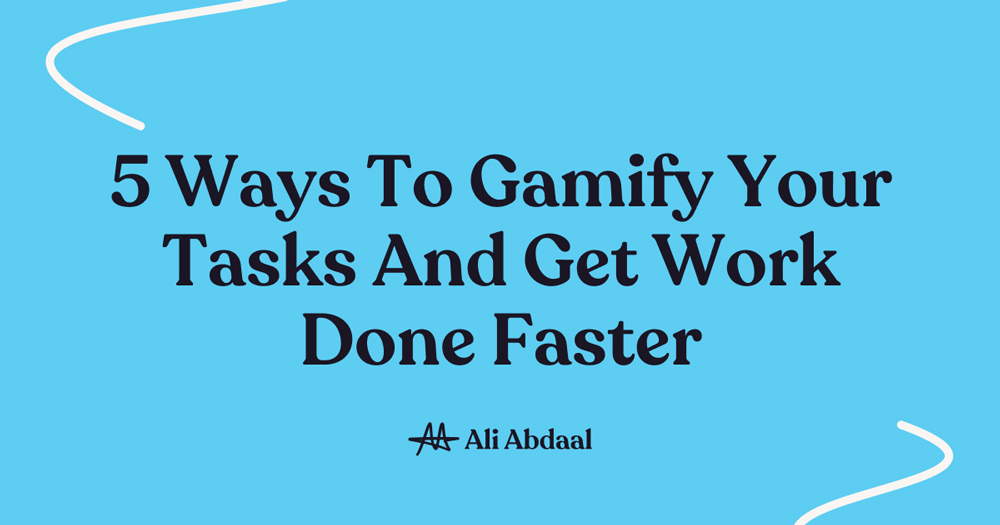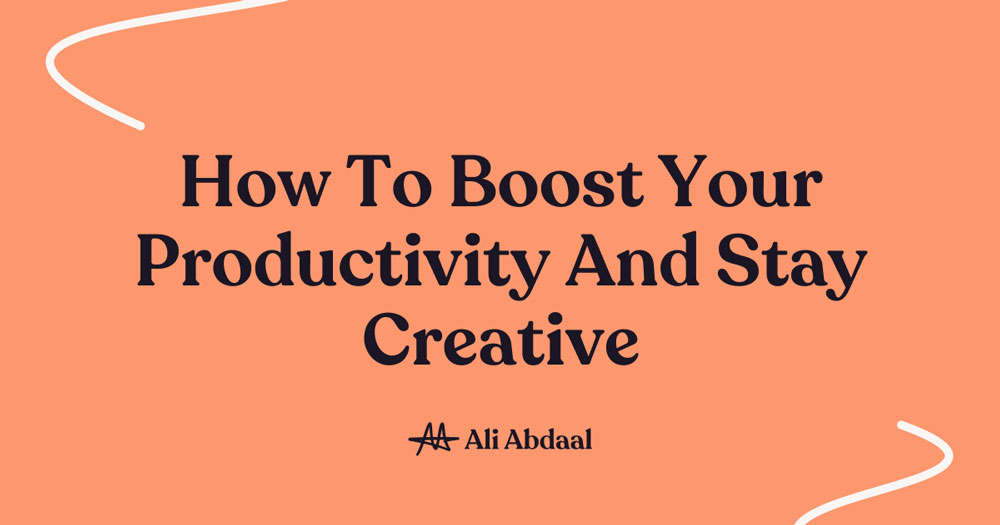The secret to enjoyable work and sustained productivity is to find a way to make what we’re doing a little bit more fun.
Now, I fully stand by this approach (it’s even the main idea of my book, Feel-Good Productivity). But, there’s a problem. Some things are just boring. There are things at work that aren’t fun, and we just don’t want to do them, but have to anyway.
For example, once a year, I need to update the 6med website with our BMAT and UCAT course dates. This just takes a few hours of work each year, but because it’s boring, I always put it off. Then get frantic emails and phone calls from parents desperate to book their kids onto one of our courses.
I’m putting off a basic task that could save me and others a lot of stress, simply because it’s just too boring.
So, if you have to deal with tedious tasks, or your 9-5 is painfully dull, you aren’t alone. I’ve felt the same frustrations and dealt with the same mind-numbing tasks.
But for those boring things, there’s an answer.
Adding a sense of fun into our work can transform it from a mundane chore to a rewarding experience.
After years of research (and writing a book about it 😜), I’ve discovered some pretty cool tricks to actually make work fun.
In this article, I’ll share seven of my favourite strategies for beating boredom and bringing some enjoyment back into your routine.
Why fun helps beat boredom at work: The science of play and productivity
I remember a time when I was working as a junior doctor and I rewatched Mary Poppins with my housemate.
The lyrics of the film’s most famous song, ‘A Spoonful of Sugar’, caught my attention:
In every job that must be done,
There is an element of fun,
You find the fun and snap!
The job’s a game.
Back then, I had no idea how true those lyrics really were.
In the years that followed, I spent many hours researching how play and fun impact productivity.
I discovered that several Nobel Prize winners attribute their success to play.
These include Giorgio Parisi, the 2021 physics laureate. He described science as “playing puzzles or reading a detective story and trying to understand who is guilty before the author tells you.”
Or Kary Mullis, the biochemist who won the Nobel Prize in Chemistry in 1993 for inventing the polymerase chain reaction (PCR), who described his work as “playing in the lab” or “playing with oligonucleotides.”
But not only Nobel Prize laureates say their work feels like play.
Tech investor Naval Ravikant described creating business as playing. He said, “I create businesses because it’s fun, because I’m into the product.” And Austin Kleon also describes this feeling in his book Steal Like An Artist:
“When I was making the poems, it didn’t feel like work. It felt like play.”
It turns out there’s a bunch of research backing that up.
Psychologists increasingly believe that play holds the key to true productivity, mostly because of 3 reasons:
- It makes us feel good
- It takes the pressure off
- It broadens our possibilities and builds our resources
Reason 1. It makes us feel good
In the late 1990s, scientist Jaak Panksepp conducted a curious experiment.
He stroked a rat’s belly with a dry paintbrush, and suddenly, the rat cried out. But not in distress. The rat was, in fact, laughing.
At the time, most scientists thought that only humans experienced emotions, because of our more complex brains and social structures.
But Panksepp’s discovery, that rats showed clear signs of joy, pointed to an alternative: that emotions must come from much more primitive areas of the brain. Play is embedded in our biology and it’s something we love.
The reason? Play releases dopamine, which makes us (and the rats) feel good.
So, by adding play and turning a mundane task into a game, we can shift it from exhausting to exhilarating.
Reason 2. It takes the pressure off
At 27, Professor Richard Feynman was already praised as one of the greatest physicists of his time.
But there was a problem: he was bored of physics.
Every time he tried to think, he felt tired, and his ideas seemed dull. He still enjoyed teaching, reading, and wandering around campus. But he didn’t feel motivated to work.
Until one day, everything changed.
Sitting alone in the university cafeteria, Feynman watched a student repeatedly toss a plate in the air. He noticed that while the plate wobbled, the Cornell logo on it wobbled even faster.
This odd observation sparked a moment of curiosity. And after reflecting on it, he remembered why he loved physics in the first place: he used to play with it. It was fun and interesting, not just work.
Inspired, Feynman spent weeks figuring out the equations behind the plate’s wobble, simply for the fun of it. His colleagues were puzzled and asked why he was doing it. “There’s no importance whatsoever,” he told them. “I’m just doing it for fun.”
Soon, he was back to pondering deeper problems, like the wobbling of electrons in an atom. He was “playing” with physics again, and this time, without the pressure, the work felt enjoyable, not exhausting.

I realised something similar when I started assisting in operating theatres.
There’s a real sense that the best surgeons are those who create an atmosphere of lightness and ease, even in the midst of life and death.
So the surgeons will play upbeat background music, and they’ll crack jokes every now and then. And the scrub nurse and the anaesthetist will be wearing a scrub caps printed with rainbows and unicorns.
They realised that when there’s a lot of pressure and the environment is very serious, people’s energy drops- as does their performance.
So, even in life-and-death situations, we can always approach work with play and fun.
There is a quote from Doctor Who that sums it up pretty well:
“I’m serious about what I do but not about the way I do it.”
Reason 3. It broadens our possibilities and builds our resources
In the late 1990s, scientist Barbara Fredrickson proposed what she called the ‘broaden-and-build’ theory of positive emotions.
The “broaden-and-build” theory is like a feel-good snowball effect. The theory basically says that when we experience positive emotions like joy, love, or peace, our minds open up. We start seeing more possibilities around us.
Because we’re feeling good, we’re more likely to notice opportunities, think creatively, and connect with others. This is the “broaden” part—our outlook and thinking expand.
As we take advantage of these new opportunities and connections, we start building new skills, relationships, and resources. Over time, these small gains accumulate, helping us become more resilient and capable. This is the “build” part. We’re creating a stronger foundation for future challenges.
So, feeling good helps us see more possibilities, and acting on those possibilities helps us grow and become even better equipped to handle whatever comes our way.
Positive emotions aren’t just fleeting feelings that come and go. They’re crucial for how we think, feel, and connect with others.
How to make your work actually fun
So, now that we know that boredom at work is the enemy and play is our ally, let’s figure out ways to fight boredom and make the actual job more fun – even the most boring tasks. I have seven key techniques you might like to try:
- Find your own play personality
- Ask yourself, ‘What would this look like if it were fun?’
- Craft your productivity playlist
- Seek out side quests
- Set yourself a challenge
- Enjoy the process, not the outcome
- Create your own ‘playlist’
1. Find your own play personality
I used to be addicted to World of Warcraft, an online game made for total nerds like me.
At the beginning of the game, you pick your character and then dive into the fantasy world of Azeroth.
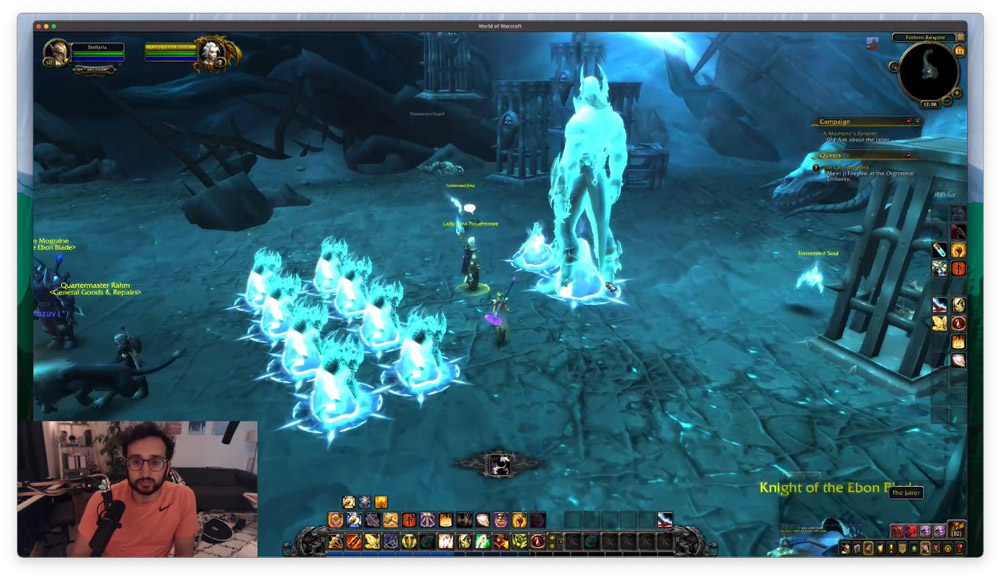
Looking back, I think the reason I spent 184 days of my teenage life on it over three years was because I loved getting into character.
While playing, I could leave Ali Abdaal behind. Instead, I transformed into Sepharoth, a tall and handsome Blood Elf Warlock who commanded a legion of demons.
This game allowed me to express parts of myself I didn’t usually show. It turned everyday experiences into something more exciting.
Now, you might be thinking, “Okay Ali, but that was a game. How does this apply to my job?”
Stepping into a character at work can help you transform boring tasks into something satisfying and fun.
And don’t worry, picking your ‘character’ isn’t about pretending to be a goblin in front of your colleagues 😆. It’s about finding which type of play resonates with you the most and embodying it.
After conducting interviews with 5,000 people, clinical psychologist Dr Stuart Brown discovered 8 ‘play personalities’:
The 8 play personalities
🎲 The Collector: Passionate about gathering and organising objects or information, whether it’s plants, vintage finds, or hidden gems in archives.
🏆 The Competitor: Driven by the desire to win and excel in games, sports and competitions.
🌏 The Explorer: Has a strong curiosity and sense of wonder. Likes to discover new places and experiences through hiking, road trips, and embracing the unknown.
🎨The Creator: Finds joy in making things. Can spend hours every day making music, drawing, gardening, painting, and more.
📖 The Storyteller: Has a natural inclination for narrative, storytelling and entertaining others. Enjoys activities like writing, dance, theatre and role-playing games.
🃏 The Joker: Loves humour, jokes, and playful pranks. Passionate about making people laugh and brightening people’s days with humour.
🎬 The Director: Enjoys organising, planning and leading others. Excels at bringing order to chaos, whether in the arts, business, or advocacy.
💪 The Kinesthete: Thrives on physical movement and sensory experiences, like acrobatics, gymnastics and free running.
If you’re not sure which ‘play personality’ describes you best, you can take this quiz to find out.
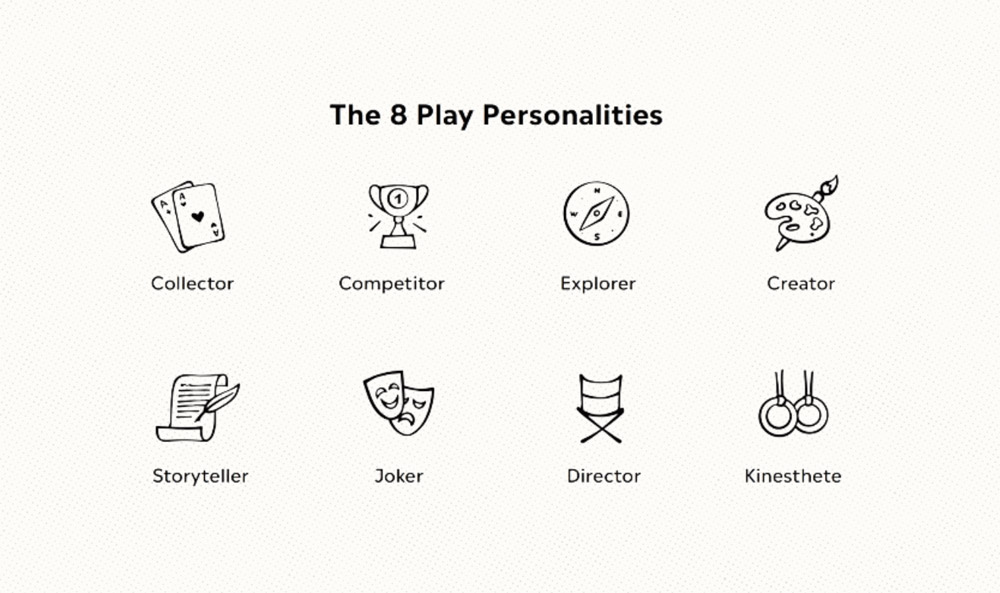
How to use the play personalities
Reflect on which of these characters you identify with most, and find ways of incorporating your personal play style into the work you do on a daily basis.
If you’re ‘the Explorer’, that might entail seeking out ways to turn a boring task, like writing a logistical email, into one that ignites your sense of discovery. For example, you could find a new coffee shop to write the email from.
Or, if you’re ‘the Competitor’, you might set up challenges or goals with colleagues or yourself to see who can complete a task faster or more efficiently.
When we uncover and embrace our play personalities, we can make work less boring by injecting creativity and enjoyment into daily tasks.
2. Ask yourself, “What would this look like if it were fun?”
Whenever I’m struggling with a task, I always like to ask myself, “What would this look like if it were fun?”
I ask myself this question so much and think it’s so important that I actually have this as my phone wallpaper 😅
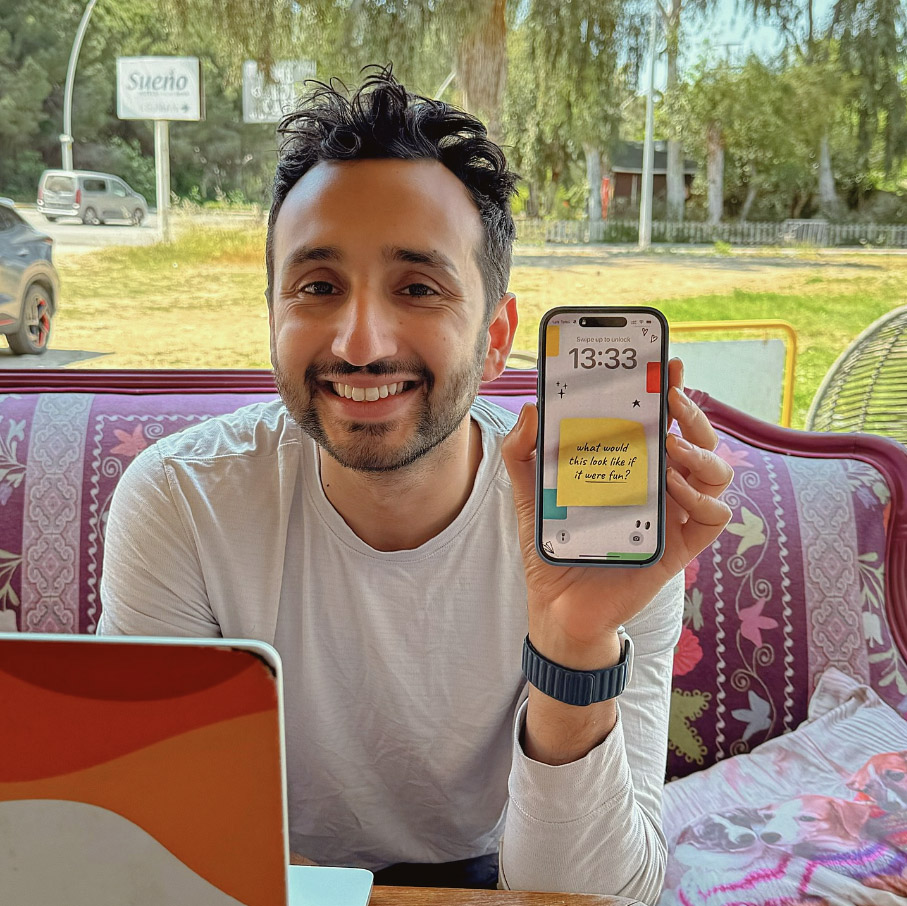
Let’s say I’m procrastinating from doing my tax return.
If doing my taxes was fun, I would probably not be sitting at my desk in my bedroom, hunched over my laptop. I’d probably take my laptop and go down to a local coffee shop. I’d order a nice latte and get to work while listening to the Lord of the Rings soundtrack.
“What would this look like if it were fun?” has been a central guiding question to a lot of my thinking on productivity.
And it’s surprisingly easy to draw upon.
Whenever you face a task that you don’t want to do, ask what it would look like if it were fun.
Could you do this task somewhere else? Maybe you could call a friend and do it together? Could you add music or enjoy a treat when you finish?
Asking yourself this simple question can radically change your approach to work. Whether you’re turning boring meetings into interesting brainstorming sessions, or gamifying your to-do list, finding fun in the task can make work a lot more engaging and enjoyable
3. Craft your Productivity Playlist
When I lived in Cambridge and had my Alexa Smart speakers set up, any time I woke up and roamed around the house, I’d play some kind of background music.
Then, I moved to London and I noticed that, because I didn’t have a proper set-up, I didn’t listen to as much music as I did back in Cambridge. My energy levels were way lower and I wasn’t as focused.
It wasn’t until I realised, “Oh, there’s no music!” and turned it on that I felt an injection of energy into the room.
If I’m feeling low in energy or struggling with a task, putting on music seems to help. There’s something about having music in the background that really energises me.
And science backs it up.
One study published in the Journal Thinking Skills and Creativity found that music with moderate ambient noise, such as instrumental tracks or nature sounds, can enhance performance on creative tasks.
Another study from the University of Birmingham revealed that listening to music you enjoy while working can increase productivity and improve your mood.
Since then, I’ve created Productivity Playlists, like my Study with me one, to minimise distractions and promote flow. This is one of my favourites to play while I write my weekly newsletter, LifeNotes.
So, spend some time crafting your perfect Productivity Playlist and see how it transforms your workday.
Some people swear by instrumentals like lo-fi beats or classical music. Others find their groove with electronic or ambient tunes. It’s all about discovering the type of audio that works best for you and using it to create a more enjoyable working atmosphere.

4. Seek out ‘side quests’
In our team, we use OKRs, a collaborative goal-setting methodology. But we don’t call them Objectives and Key Results. We actually call them ‘quests’.
So we ask ourselves, “What’s the quest for this quarter?” And we also give silly names to the quests.
For example, one goal we had before releasing my book was to try and get loads of pre-orders. We titled this quest Operation Banger.
The goal was to get the book to be a banger and the whole team was then oriented around the idea of Operation Banger. It was just much more fun than having the goal “Get X number of book pre-orders one month before it’s released.”
There’s something about using this terminology that makes the mind approach it in a more fun and enjoyable way.
And you can translate that into your work, too.
One method is to seek out what I call ‘side quests’.
Let’s say I’m writing an article about time management and get writer’s block. I find it useful to follow my curiosity and explore a related topic for a while as a fun side quest. This usually leads to:
- Accidental progress on my time management piece
- Feeling more relaxed, and my writer’s block disappearing
- Generating other great ideas that I can follow up on later
Adding a side quest to your day invites curiosity, exploration, and playfulness and you might even stumble upon something amazing and completely unexpected.
I also like to use side quests to keep on top of things in my personal life. If my ‘main quest’ for the day is to write 1000 words of my book, then my ‘side quest’ might be to call a friend I haven’t seen in a while and catch up. This way, I’m able to make progress in lots of different areas of my life – not just my work.
5. Set yourself a challenge
Rather than slogging through a workout, I have way more fun at the gym if I track my progress and see the incremental gains.
This is gamification 101: video games have level-up bars and points because they make any task fun. And it’s the same reason why YouTubing is so addictive. You can see your views and subscribers spike in real-time every time you post a video.
So, to make any task more fun, give yourself a challenge, like in a video game.
You could compete with a friend, challenge yourself to hit a target (e.g., write 300 words every 30 minutes). Or try the Seinfeld Strategy, building up a streak for long enough that you won’t want to break it.
My team uses these methods to stay on track. We’re aiming to publish roughly two long-form videos per week, and we have a chart that reminds us of that commitment every day. We write down what videos we’re aiming to release that week, and we all get a little kick of satisfaction when they’re uploaded and crossed off.
Challenges can help you reach your goals because they add time pressure, accountability, and fun – so you don’t drop new habits or procrastinate on a task out of boredom.
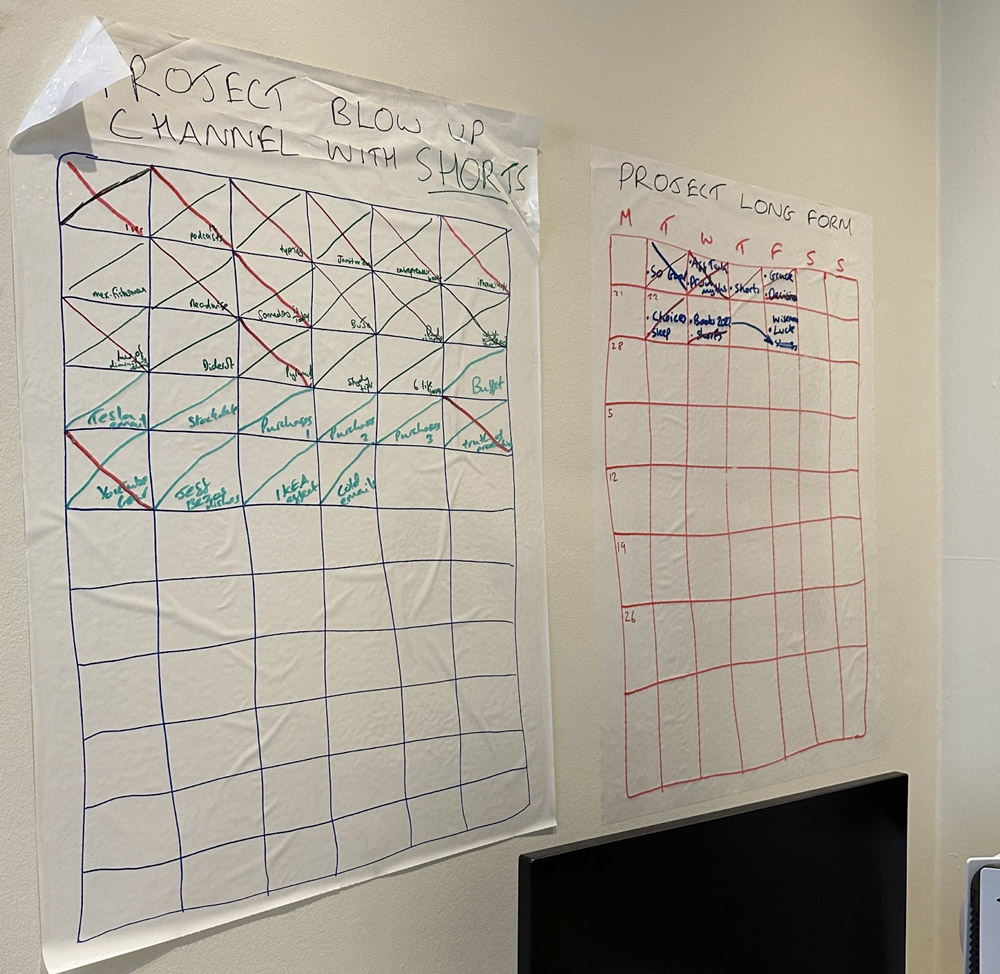
6. Enjoy the process, not the outcome
According to psychologist Mihaly Csikszentmihalyi, the pioneer of the study of ‘flow’, we’re more likely to enjoy a task if we can learn to focus on the process rather than the outcome.
But how can we enjoy more mundane or even unpleasant situations?
For my book Feel-Good Productivity, I interviewed a guy named Matthew Dicks. He is now an internationally bestselling author, but when he was young, he used to work in a McDonald’s drive-through and found his work was really boring.
He decided to explore whether he could find satisfaction not in the job’s end result (his tiny pay check) but in the process itself.
So he asked himself: “How can I make this feel more fun?”
He came up with an idea. Every day, he’d choose a different sauce ,and his mission would be to upsell the customers on that particular sauce. Monday was barbecue sauce day, Tuesday was sweet and sour sauce day, Wednesday was curry sauce day…you get the idea.
So customers placed their orders and Matthew asked, “Would you like barbecue sauce with that?”
If they said yes, he would upsell them the barbecue sauce and try and get them to buy two.
If they said no, he would try and convince them to buy it by saying something like, “My last customer was reluctant, but when she tried the sauce, she loved it.’”
He soon found himself looking forward to his shifts, excited to see how many customers he could get to try the BBQ sauce.
By doing so, he managed to apply the principle of play to his work.
It made the customer’s lives better because they had a more interesting interaction. It made his life better because he was having more fun. And it actually improved the profits of the McDonald’s franchise he was working at, so his manager loved him.
His job wasn’t inherently enjoyable. But he had created a way to enjoy it.
7. Create your own ‘playlist’
Even if there is nothing you can do to make work enjoyable, you can take a ‘play break’ to recharge and energise yourself.
Intervals of play and relaxation are essential to happiness. So, to make sure you incorporate play into your breaks, create your Playlist.
The Playlist is a list of play activities that you enjoy and can do for at least 5 minutes a day.
Some ideas could be:
- Planning a trip
- Eating a snack
- Reading something funny or interesting
- Gardening
- Playing an instrument
- Stretching
The list is endless.
Once you’ve chosen the activities that go into your personal Playlist, it’s time to take action. Whenever you feel you’re tackling a boring task, take breaks and enjoy the activities in your Playlist. The task at hand won’t stop feeling boring, but you’ll be more energised to face it and finish it faster.
Beating boredom at work isn’t about drastic changes. It’s about incorporating fun into our day-to-day tasks.
Work can be stressful (and sometimes boring), but it can also be a source of satisfaction and excitement if you let it.
I really hope these tips and tricks help you next time you’re faced with that boring job you’ve been putting off – you can do it, and I promise it won’t be as bad as you think. And if you’re looking or an extra way to add into you day, check out Productivity Lab. There you can meet and work alongside a community of other people interested in getting more from their time, and enjoying the journey along the way. It’s a blast, and we’d love to have you there.


